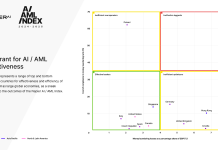With the challenges of financial crime increasing with an ever-growing digital presence for firms and threat actors alike, there is a growing desire in the industry for more real-time management of such threats. What are the challenges and opportunities for such technologies?
According to Holly Sais Philippi, CEO of RegTech firm Alessa, real-time AML compliance is becoming increasingly critical as financial institutions face the growing digital presence of bad actors.
She remarked, “As criminals leverage advancements in technology to exploit financial systems, firms are looking to keep pace by implementing real-time monitoring and cutting-edge AML systems. These systems present several challenges, but also offer significant opportunities for enhanced compliance.”
However, the Alessa CEO believes a rocky road lies ahead for its integration into traditional systems. “Ever tried to fit a square peg into a round hole? That’s what integrating real-time AML tech into old-school, legacy systems feels like for many financial institutions,” said Philippi.
She went on, “It’s costly, it’s messy, and more often than not, it’s frustrating. These older systems weren’t built for the kind of nimble, real-time action that modern AML requires. Additionally, the volume of data generated by real-time systems can be overwhelming, making it difficult to filter out false positives while identifying legitimate threats quickly and accurately. This can lead to increased operational costs and inefficiencies, as compliance professionals try to identify true threats amidst a sea of false positives.”
Philippi believes global AML compliance often feels like trying to learn different dance routines – each with its own rhythm, steps and rules – whilst having to perform them all pitch perfectly.
“Each jurisdiction has its own regulations, and it’s a real balancing act for businesses trying to operate internationally,” she stated. “Keeping up with evolving AML requirements and ensuring that systems are both compliant and flexible enough to adapt to changes is critical.”
Despite this, there is significant upside for firms who adapt to this new technology. “Imagine being able to catch the villain in the act instead of watching the security footage after the heist is over. That’s the beauty of real-time AML. It turns institutions from reactive spectators into proactive gatekeepers. It’s about preventing bad transactions as they happen, not just cleaning up the mess later,” said Philippi.
“That kind of proactive stance doesn’t just keep criminals at bay—it builds trust. Clients, regulators, and even your internal team start to see your institution as one that’s truly making headway in catching the bad actors,” she added.
For many financial organisations, the speed of onboarding is a big factor in attaining new businesses – with slower onboarding times cause new clients to abandon the organisation. This, Philippi outlines, highlights the ‘world of instant gratification’ that we live in – with waiting for anything feeling like a ‘relic of the past’.
“Real-time AML solutions can speed up the onboarding process, verifying identities and screening for red flags in real time and in this evaluation process a critical component for organizations is to understand how that Real-time AML solution uses technology to reduce false positives in the process, that is a critical component,” she said.
For all financial institutions, automation is providing significant upside in efficiency and time gains – with more time to focus on the more important work over the more tedious, time-heavy tasks of the past.
For Philippi, similarly to transaction monitoring, real-time AML solutions with reporting capabilities can fully automate the reporting process.
She said, “This leads to more efficient compliance workflows, as teams no longer have to complete tedious manual reports, while also increasing reporting accuracy, removing the variable of human error. Also, solutions that can automate the regulatory reporting process ensure your organization is filing promptly, tracking the report submissions, and ensuring no errors occurred which might delay the report getting to law enforcement. Compliance teams can finally focus on the bigger picture instead of getting lost in the weeds of tedious administrative work.”
One of the benefits of the evolving technologies used by financial organisations is their ability to become smarter – commonly through machine learning. Advances in machine learning, Philippi outlines, provide an opportunity for financial institutions to improve the accuracy of real-time AML systems.
She said, “Modern, real-time AML systems can use learnings from past patterns and enhance the detection of suspicious activities while reducing false positives as they accumulate more and more organization data. With every transaction, and every alert, the system gets a little smarter, a little sharper, and a lot more efficient at filtering out the noise. Fewer false positives mean more focus on actual threats, better resource allocation, and less fatigue for compliance officers. It’s about working smarter, not harder.”
Philippi concluded, “At the end of the day, real-time AML compliance is a mixed bag—it comes with its share of headaches, but the rewards are well worth the effort. It’s like climbing a mountain: the path is steep, the obstacles are real, but the view from the top? Absolutely worth it. By tackling the challenges head-on, financial institutions can not only fortify themselves against crime but also position themselves as leaders in a fast-changing market”
Necessary evolution
Nickii Malia, business development manager at KYC Portal, believes that as transactions become increasingly digital and instantaneous, traditional AML systems are evolving to handle the speed and complexity of modern ecosystems.
She remarked, “Real-time transactions generate massive volumes of data that must be processed almost instantaneously. Legacy AML systems often struggle to keep up with this speed, leading to potential gaps in monitoring. Real-time AML systems enable financial institutions to identify suspicious transactions and activities as they happen, reducing the risk of allowing illicit transactions to proceed.”
This, she claims, improves the overall effectiveness of AML programs. She added that this also helps with an improved customer experience. “Real-time compliance systems can offer smoother and faster services for legitimate customers by reducing the number of unnecessary delays or account freezes. This is particularly relevant in the digital payments space where customers expect instantaneous transactions,” she said.
There is also a pressing need for financial institutions to comply with sprawling regulatory frameworks depending on their jurisdiction. “Having a fully dynamic, real-time AML system allows for continuously being able adapt to evolving regulatory standards, making it easy to stay compliant globally. Nowadays so many new RegTech solutions are emerging to streamline real-time compliance. These tools offer more efficient ways to monitor, analyse, and report suspicious activity while maintaining regulatory compliance,” said Malia.
She finished, “With real-time AML systems, financial institutions can achieve faster, more accurate monitoring, reducing the risk of financial crime while also streamlining operational costs.”
Challenges and benefits
For Emil Kongelys, CTO of RegTech firm Muinmos, there are two key challenges but many very real benefits.
He explained, “The biggest challenge, perhaps, is consolidating the different AML related processes, in such a way that creates one clear, easy to manage process, which is still highly accurate and compliant. In many companies, AML is still managed in a fragmented manner, using different providers and systems, a fact that makes it difficult to have one clear, actionable process.”
Another challenge in his view is managing several KYC/AML solutions at the same time – including integrating them and managing contracts. This, he says, makes the procurement and management of vendors fairly burdensome.
“The solution for those issues is to, first, define the compliance needs in the most accurate manner possible. For example, many do not see Regulatory Classification as part of the onboarding process, despite it being a very substantial part of it. One needs, therefore, to sit with all parts of the organisation – Sales, Legal, Compliance, Risk, IT etc. – and then to select one or two vendors that can cover most of the requirements,” he remarked.
He gave an example, “For example, we at Muinmos try to help our clients by covering the entire onboarding process, including Client Classification, CRA, AML checks through data-sources integrated into us etc. – so our clients do not need to manage many integrations into their systems, and can use us as a stand alone solution. This solves them the headache of managing 6-7 providers.”
Increasing complexity
In today’s digital-first world, the threat landscape is more complex than ever, claims Flagright growth manager Joseph Ibitola.
He said, “As more bad actors leverage sophisticated digital tools, real-time AML compliance is a necessity. The ability to detect and respond to suspicious activity in real-time could be the difference between catching a money laundering attempt and letting it slip through the cracks.”
This is the opinion of Ibitola is where Flagright steps in. “Our real-time AML platform is designed to break down the barriers that often prevent firms from adopting such technology. One of the biggest challenges firms face is siloed data and fragmented systems, which makes it nearly impossible to get a clear, real-time view of suspicious activity.
“Flagright’s solution integrates seamlessly with existing infrastructures, bringing all of that data into one cohesive ecosystem that’s ready to be analysed in real time.
Flagright’s AI-driven transaction monitoring doesn’t just flag suspicious behaviour, it learns from every interaction, ensuring that the system becomes more accurate and responsive over time. For firms that are serious about real-time AML, this isn’t just about ticking boxes; it’s about staying a step ahead of increasingly sophisticated criminals.”
What is the opportunity from this? In the opinion of Ibitola, companies that embrace real-time AML will not only be better positioned to prevent financial crime but will also gain an edge in regulatory relationships. Flagright’s technology helps simplify reporting and auditing processes, turning compliance from a burden into an opportunity for growth.
Utilising technology
According to RelyComply, a South African RegTech firm, the window of opportunity for financial companies to screen people or payments is getting smaller and smaller.
The firm said, “If technologies aren’t in place to provide real-time verification, often as little as half a second, those compliance protocols will lag behind newly introduced regulations.
“Platforms are expected to alert suspicious activity in a fraction of the time manual processes are used to take out potentially billions of data points. At the start of 2025, EU payment service providers (PSPs) must be able to instantly verify the legitimacy of euro-based payments so customers can receive their monies. It’s a requirement long in the making, mainly due to difficulties in ensuring instant payments become the norm: their costs are traditionally high, as are the outgoing expenses to conduct transaction-by-transaction sanction screening.”
The firm added that now that real-time AML is becoming not just recommended but mandatory, digital platforms must be utilised.
“To identify ill-intentioned bad actors and their transactions, they must be checked by following daily watchlists through automated screening 24/7. Financial institutions can give the thumbs-up immediately to legitimate money transfers or reject and investigate others. This should already be in place to make FIs more efficient and weed out potentially laundered money that hinders the ability to keep legal cash flowing.
“There’s a distinct step-up required of PSPs, but streamlining AML for transaction screening and monitoring now will be beneficial in the future. It saves compliance costs while facilitating global payment transfers, especially if the intended EU instant payments scheme is successful and implemented elsewhere,” RelyComply concluded.
Copyright © 2024 RegTech Analyst
Copyright © 2018 RegTech Analyst






